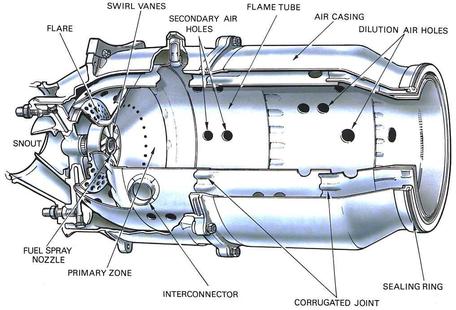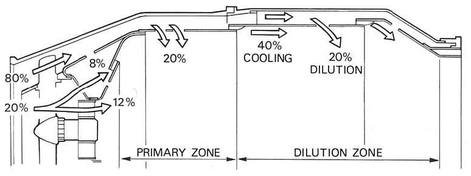Detailed Working of a Gas Turbine Engine Combustion Chamber
After the air is compressed by the compressor and by the diffuser, it enters into the combustion chamber. As the compressed air enters the combustion chamber, it is mixed with fuel by the fuel injectors. When an aircraft is started, igniter plugs are turned on; however, they are shut off shortly after the engine is started. The combustion inside the combustion chamber continues while the engine is running because the fuel injectors continuously supply the engine with fuel.

Approximately 20 per cent of the air mass flow entering the combustion chamber is taken in by the snout or entry section. Immediately downstream of the snout are swirl vanes and a perforated flare, through which air passes into the primary combustion zone.
Through the wall of the flame tube body, adjacent to the combustion zone, are a selected number of secondary holes through which a further 20 per cent of the main flow of air passes into the primary zone. The air from the swirl vanes and that from the secondary air holes interacts and creates a region of low velocity recirculation or vortex similar to a smoke ring, which has the effect of stabilizing and guiding the flame.
The temperature of the gases released by combustion is about 1,800 to 2,000 deg. C., which is far too hot for entry to the nozzle guide vanes of the turbine. The air not used for combustion, which amounts to about 60 per cent of the total airflow, is therefore introduced progressively into the flame tube.
Approximately a third of this is used to lower the gas temperature in the dilution zone before it enters the turbine and the remainder is used for cooling the walls of the flame tube. This is achieved by a film of cooling air flowing along the inside surface of the flame tube wall, insulating it from the hot combustion gases.

Thus, there are two types of airflow in the combustion chamber: primary airflow and secondary airflow. Primary airflow is the air that is actually used for combustion. Secondary airflow is air that is used cool the combustion chamber, as well as, the combustion gases entering the turbine section.
The combustion chamber represents the “bang” part of the engine.